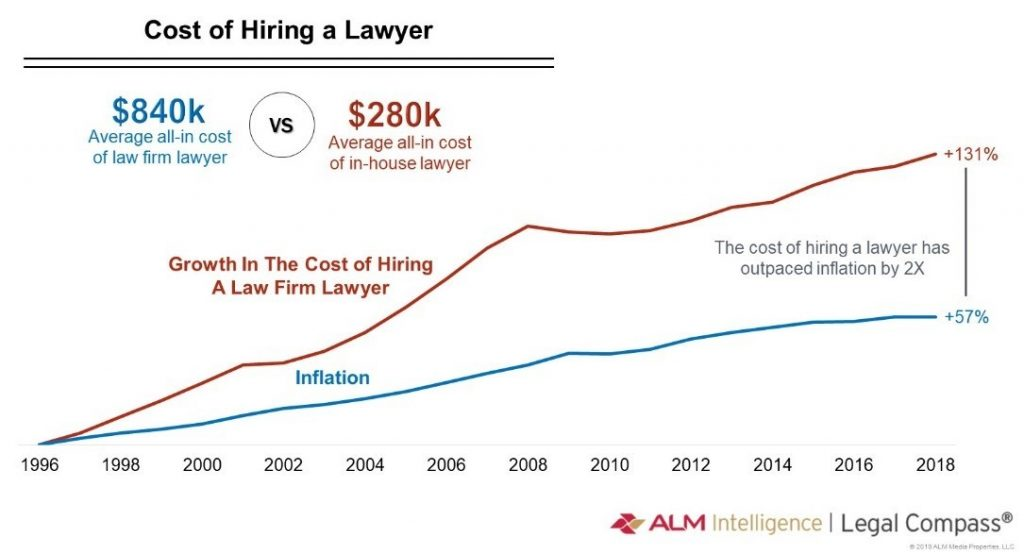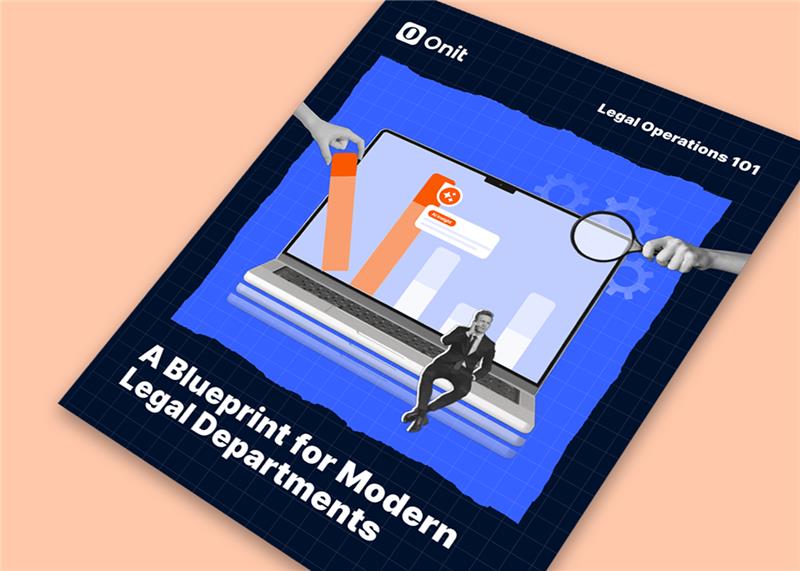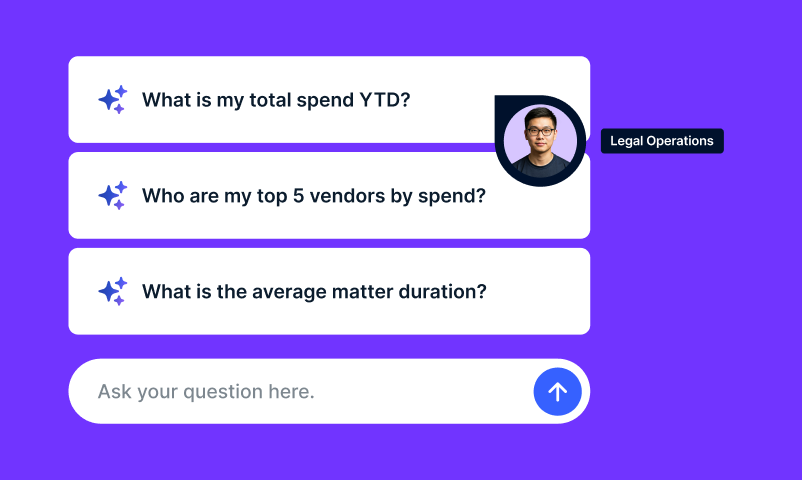
Obwohl Legal Operations eine relativ etablierte Funktion ist (nur 2 % konzentrieren sich überhaupt nicht darauf), übertragen 44 % der Unternehmen die Aufgaben einem Unternehmensjuristen, anstatt eine dafür zuständige Fachkraft einzustellen. Der Trend geht jedoch dahin, spezielle Stellen für Legal Operations zu schaffen und Teams aufzubauen. Wie können Sie also Ihr bestehendes Rechtsteam auf den Erfolg im Bereich Legal Operations vorbereiten und schulen?
WAS SIND LEGAL OPERATIONS?
Legal Operations ist wohl das neueste Modewort in der Rechtsbranche, aber die Funktion gibt es schon länger, als Sie vielleicht denken. Das Corporate Legal Operations Institute (CLOC), das in letzter Zeit immer mehr an Bedeutung gewinnt, wurde in den USA bereits 2010 gegründet. Wenn man sich anschaut, was Legal Operations ist – Effizienzsteigerung, Ausgabenkontrolle usw. -, dann haben viele Rechtsabteilungen dies schon seit Jahren getan, ohne es so zu nennen.
Eine dieser Rechtsabteilungen ist die ECE Projektmanagement G.m.b.H. & Co. KG („ECE“). General Counsel Joachim Kämpf erklärt: „Wir beschäftigen uns schon länger mit Legal Operations“, haben es aber nicht so genannt. Der Schwerpunkt von Legal Operations lag bisher auf der Überwachung der externen Anwaltskosten und der Ableitung von KPIs. Jetzt verwenden wir „Legal Operations“, um weitere Themen wie Vertragsmanagement (von der Vorbereitung des Vertrags bis zum Abschluss, über die interne Bearbeitung bis zur Kündigung), Risikomanagement und unternehmensinternes Wissensmanagement zu umfassen.“
Legal Operations sind alle Funktionen der Rechtsabteilung, die nicht zum Recht selbst gehören. CLOC unterteilt diese Bereiche in 12 Kompetenzen auf drei Reifegraden, die Sie auf der Website von CLOC finden können. Zu den typischen Fähigkeiten und Verantwortlichkeiten von Legal Operations gehören:
- Definition und Förderung von Initiativen zur Verbesserung der Effizienz und der Prozessabläufe.
- Verwaltung der Richtlinien für externe Rechtsberater, der externen Kosten (Transparenz, Kontrolle und Reduzierung) und des Abteilungsbudgets.
- Optimierung der Kanzleileistung für ein optimales Preis-Leistungs-Verhältnis.
- Implementierung, Messung und Analyse von Metriken, die als Entscheidungsgrundlage dienen, und deren Umsetzung in Maßnahmen, die zu Verbesserungen führen.
- Implementierung von Technologien zur Erreichung von Abteilungs- und Geschäftszielen.
- Funktionsübergreifende Zusammenarbeit, um den Wert der Rechtsabteilung innerhalb der Organisation zu demonstrieren.
- Verstehen und Überwachen der Risiken, der Risikobereitschaft und des Risikoprofils der Rechtsabteilung im Rahmen der Organisation.
Warum also der neue Fokus auf Legal Operations? Da die Unternehmen immer umfangreicher und komplexer werden, steigt auch der Umfang und die Breite des erforderlichen juristischen Fachwissens – und damit auch die Kosten. General Counsel stehen mehr denn je unter Druck, ihre Rechtskosten zu rechtfertigen, die Effizienz ihrer Abteilung zu verbessern und mit dem gesamten Unternehmen zusammenzuarbeiten. Joachim Kämpf, General Counsel der ECE, erklärt: „Legal Operations wird uns näher an das Geschäft und damit an die anderen Fachabteilungen heranführen und die Rechtsabteilung wird eine andere, wichtigere Rolle im Unternehmen einnehmen.“ Mit dieser Forderung, die Rechtsabteilung mehr „wie ein Unternehmen“ agieren zu lassen, geht ein Bedarf an Kostenkontrolle und Prozessverbesserung einher. Das Problem für ein traditionelles Rechtsteam ist dabei ein zweifaches. Erstens. Der vorrangige Zweck der Rechtsabteilung wird immer darin bestehen, in Rechtsangelegenheiten zu beraten. In Zeiten hoher Arbeitsbelastung oder bei unzureichender Personalausstattung des Teams werden die operativen Tätigkeiten in den Hintergrund treten. Zweitens. Das Erreichen von Betriebs- und Geschäftszielen erfordert Fähigkeiten, die nicht unbedingt zum Standardrepertoire eines Anwalts gehören.“
ENTWICKLUNG VON LEGAL OPERATIONS-FÄHIGKEITEN IM CORPORATE LEGAL TEAM
Legal Operations ist eine relativ etablierte Funktion, aber viele Unternehmen übertragen die Aufgaben einem Unternehmensjuristen, anstatt eine dafür zuständige Fachkraft einzustellen. Der Trend geht jedoch dahin, spezielle Stellen für Legal Operations zu schaffen und Teams aufzubauen. Unabhängig davon, ob Ihre Rechtsabteilung über einen speziellen Mitarbeiter für Legal Operations, ein ganzes Team oder einen Rechtsberater verfügt, der Legal Operations als Teil seines „Tagesgeschäfts“ betreibt, ist es jetzt an der Zeit, Ihr gesamtes Rechtsteam für die Zukunft zu rüsten und es dazu zu ermutigen, über die Ausübung des Rechts hinaus zu denken. Inhouse Juristen verfügen über viele Fähigkeiten, die sie für eine erfolgreiche Tätigkeit im Bereich Legal Operations benötigen – einschließlich Kanzleimanagement, Unternehmenskenntnisse und ein tiefes Verständnis für die täglichen Abläufe und Herausforderungen der Rechtsabteilung. Dies allein reicht jedoch nicht aus, und die Qualifikationsdefizite der Anwälte liegen in der Regel in den Bereichen Technologie und Software, Change Management, Budgetierung und Datenauswertung.
Personen mit all diesen Fähigkeiten werden selten zu finden sein. Ob der Leiter der Legal Operations ein Jurist oder ein Nicht-Jurist sein sollte, ist umstritten, aber die meisten sind sich darin einig, dass das Ziel ein gemischtes Team aus Juristen, Nicht-Juristen und Fachleuten sein sollte, das zumindest über Grundkenntnisse in allen Funktionen der Legal Operations verfügt. Ben Eason, Legal Transformation, Barclays, drückt es treffend aus: „Legal Operations kann schief gehen, wenn es zwei Seiten des Legal Teams gibt: die Juristen und die Nicht-Juristen. Das gesamte Team sollte zusammenarbeiten.“ Amy McConnell, Head of Legal Operations, Vodafone Business, stimmt dem zu: „Wir sind der Meinung, dass alle Anwälte ein besseres Verständnis von Projektmanagement, agilen Methoden, der Durchführung von Experimenten und Versuchen sowie der Gestaltung und Verbesserung von Prozessen haben sollten. Wir führen Schulungsprogramme für alle durch, die lernen und sich weiterentwickeln wollen.“
Einige der Möglichkeiten, diese zusätzlichen Fähigkeiten in Ihr juristisches Team zu integrieren, sind:
JOB SHARING/SHADOWING
Ziehen Sie in Erwägung, Juristen im Finanzwesen, im Vertrieb, im Marketing, im operativen Geschäft, im Produktmanagement oder in der Datenanalyse einzusetzen – in jedem Bereich des Unternehmens, der ihre Fähigkeiten in einer Weise erweitert, die einer der Funktionen von Legal Operations entspricht. Die Herausforderung besteht darin, Kollegen aus diesen anderen Abteilungen zu finden, die qualifiziert genug sind, um einen echten „Jobtausch“ in die Rechtsabteilung vorzunehmen. Shadowing ist in solchen Fällen eine gute Alternative. Iain MacDonald, Legal Operations Consultant, ehemals bei der Lloyds Banking Group, rät den Führungskräften, auch die Nicht-Juristen im Legal Operations-Team weiterzubilden: „Wenn man den Nicht-Juristen die Möglichkeit gibt, Juristen zu hospitieren, können sie die unterschiedlichen Aufgaben, Verantwortlichkeiten und Herausforderungen, mit denen die Juristen konfrontiert sind, besser verstehen und hoffentlich engere Arbeitsbeziehungen innerhalb der Funktion aufbauen.“
PROJEKTLEITUNG
Es ist mehr als wahrscheinlich, dass Mitglieder Ihres Teams bereits an großen Projekten wie M&A Projekte mitgewirkt haben, allerdings nur aus rechtlicher Sicht. Wenn sie das gesamte Projekt leiten, werden sie mit anderen Bereichen des Unternehmens und deren Auswirkungen auf die Gesamtempfehlung und das Ergebnis vertraut gemacht. Es muss nicht einmal ein so großes Projekt sein. Ein interner Markenwechsel, eine Produkteinführung oder eine HR-Initiative reichen völlig aus. Die Beteiligung an einer Software-Einführung wäre von Vorteil. Die Leitung von Projekten, an denen Interessengruppen aus mehreren Abteilungen beteiligt sind, unter Einhaltung von Fristen und des Budgets ist ein wichtiger Bestandteil von Legal Operations, so dass die Leitung eines funktionsübergreifenden Projekts diese Fähigkeiten fördert.
TRAININGS, KONFERENZEN, NEWSLETTER
Der offensichtlichste Weg, die benötigten Fähigkeiten in Ihrem Team aufzubauen, sind Schulungskurse, aber auch Konferenzen können Wissen vermitteln und inspirieren. Schulungen müssen keine externen Kosten verursachen, da ein Großteil der Fähigkeiten bereits im Unternehmen vorhanden ist und Kollegen aus anderen Abteilungen bei der Schulung helfen können. Dies ist eine Technik, die im Barclays Legal Transformation Team angewandt wird, sagt Ben Eason: „Wir nutzen Weiterbildungsinitiativen, um Anwälte zu Themen wie Datenanalyse, Cloud, Cyber Security, KI und Werbung zu schulen – und die Fachleute im geschäftlichen Hintergrund über die Praxis des Rechts und den Rechtsmarkt. Für uns ist es wichtig, dass das gesamte Team die Menschen, Abteilungen und Systeme im gesamten Unternehmen kennenlernt, damit sie den größtmöglichen Wert schaffen können.“
TECHNOLOGIE EINFÜHREN UND NUTZEN
Ermutigen Sie Ihr Team, darüber nachzudenken, was sie bei der täglichen Arbeit bremst, und zu untersuchen, ob diese Probleme durch Technologie gelöst werden könnten. Ermutigen Sie sie, Software-Tools zu recherchieren und zu empfehlen, die ihnen und dem gesamten Team helfen könnten, und das Implementationsprojekt zu leiten.
REGELMÄSSIGE PRÄSENTATIONEN UND Q&AS ZU UMSATZ, GEWINN UND ZIELEN DES UNTERNEHMENS
Wenn in Ihrem Unternehmen regelmäßig „Town Halls“ stattfinden, bei denen aktuelle Finanzdaten und Unternehmensleitbilder vorgestellt werden, sollten Sie Ihr Team ermutigen, daran teilzunehmen, oder, falls dies nicht der Fall ist, solche Veranstaltungen nur für die Rechtsabteilung einrichten. Wecken Sie das Interesse Ihres Teams an der finanziellen Gesundheit des Unternehmens und daran, wie die Rechtsabteilung dazu beitragen kann. Ein modernes juristisches Team muss die Finanzterminologie fließend beherrschen und mit der Budgetierung und Berichterstattung vertraut sein.
Möchten Sie mehr über das Thema erfahren? Laden Sie unser praktisches Whitepaper „Wie Sie ein erfolgreiches Legal Ops Team aufbauen“ herunter.













